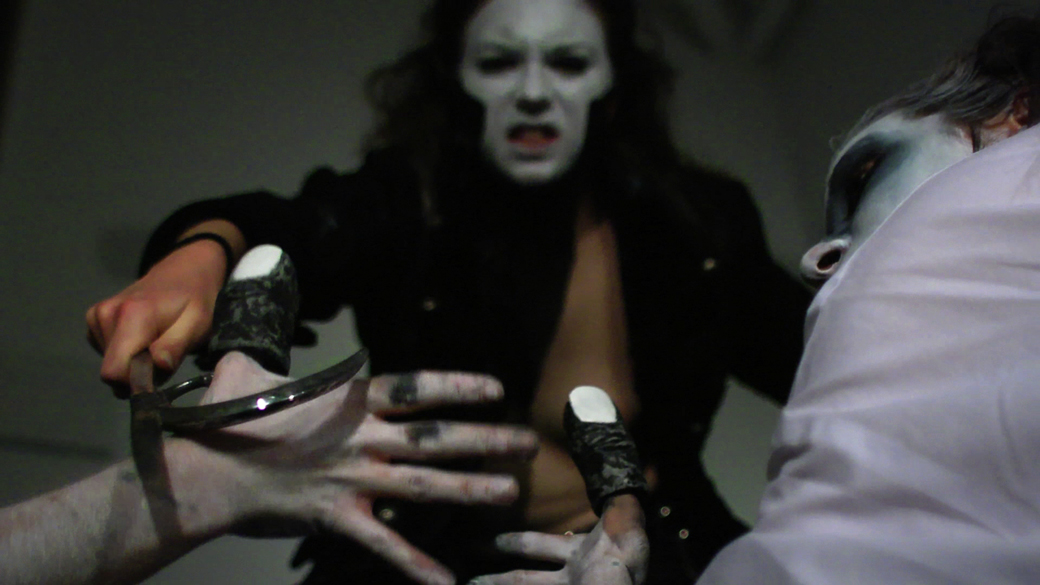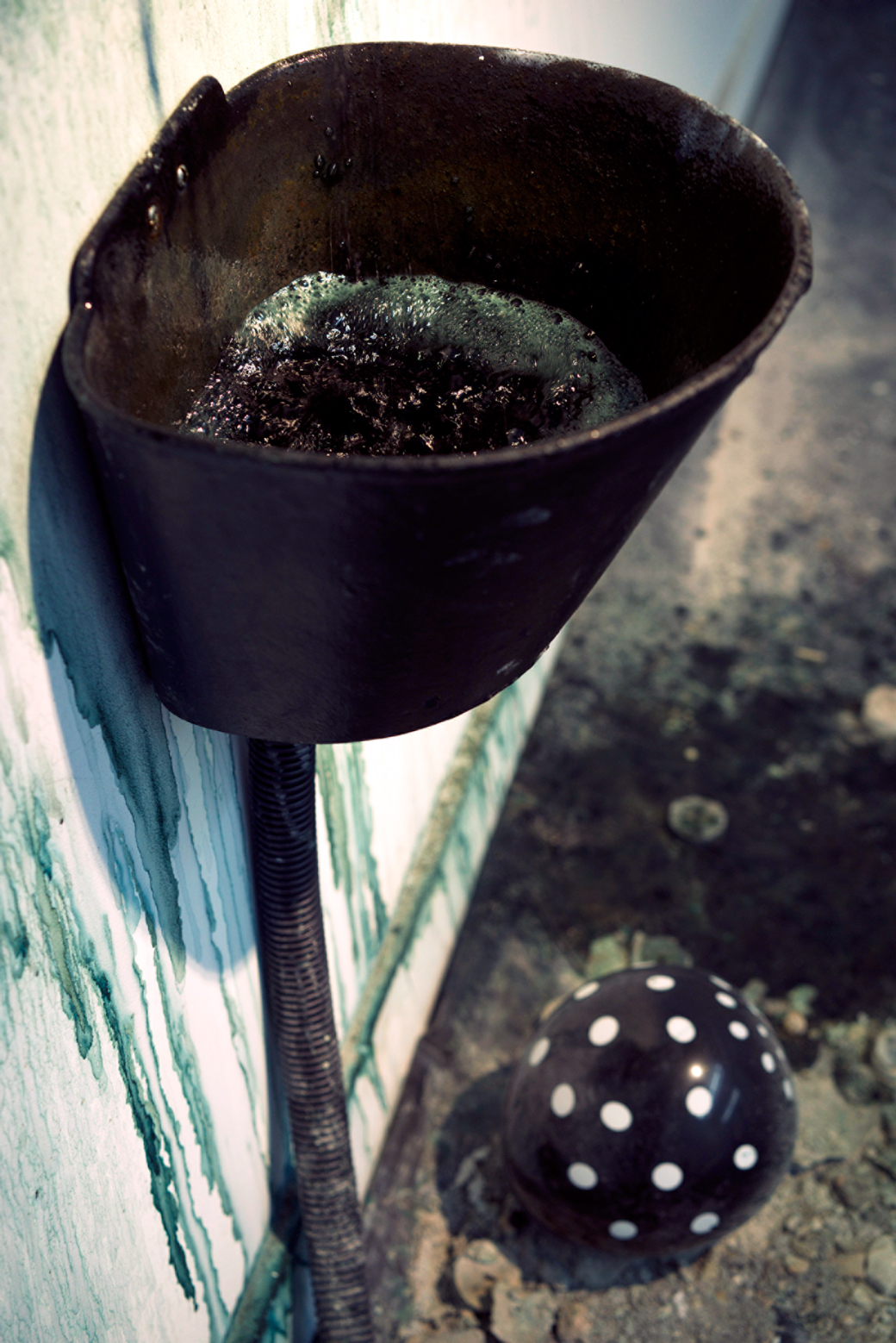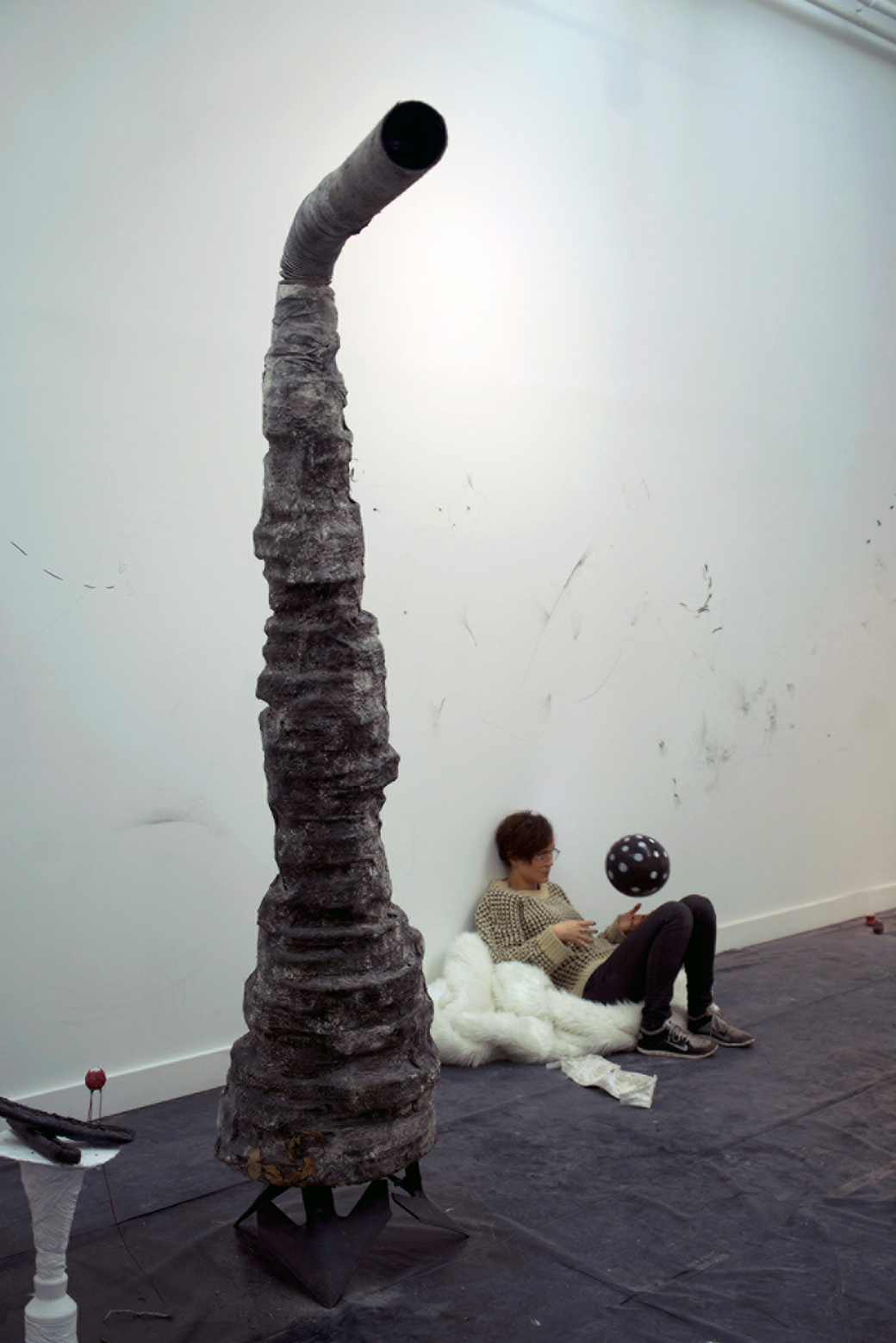Editor’s Note: This essay was written in 2014 as part of the CUE Art Foundation Young Art Critics program, and in conjunction with the exhibition Lucia Love: Reflecting Pool. The author, Louis Doulas, was mentored by Thomas Micchelli, an artist, writer, and filmmaker as well as co-editor of Hyperallergic Weekend.

Lucia Love. Orifficial Cup, 2014. Magicsculpt, wire, acrylic;
6 x 2.5 x 2 inches. Courtesy the artist and CUE Art Foundation.
Lucia Love’s 2014 installation, Reflecting Pool, at the CUE Art Foundation, is theatrical and dramatic, and unlike most conventional exhibitions, in which the default setting is a brightly lit white cube, hers is a darkened, immersive environment, shadowy and murky, like a dream, or rather, like a nightmare.
The wooden floors of the gallery space are sheathed in black construction tarp and await spillover—though if there are any stains, blood, or saliva, for example, they will be invisible to us. Scattered haphazardly across this black tarp are what appear to be random objects of dubious utility, seemingly dropped in place mid-use, perhaps in a moment of trepidation. Precarity extends to innocent looking objects, the small and medium-sized ceramic cups arranged in aggregates across the space, whose vessels are either too narrow or too wide to be of any use—a domestic and survival horror. A faint hum and the sound of running water turns our attention to the far-end of the space, and we see black liquid pouring from out of a busted pipe sprouting from the wall, its infrastructure, its bundles of pipes and wires, all exposed. It reads as a junky impromptu fountain of some sort, or a slop sink without its control knobs. The dimly spot-lit wall, from which its mechanical organs dangle, acts as its splashguard, its stains let us know it’s been spewing dark matter for quite some time now. In various corners, two huge, monolithic, ash-grey bendy straw sculptures tower over all. A third is toppled over, defenseless, vulnerable even, but in a second take, it is alarming, its base is comprised of thick steel tractor blades, threatening dismemberment with one misplaced step. There is a glint in the darkness. It’s a hook, closely resembling the spoke of a fireplace poker, pierced in the wall, fastened in place like a sword in stone that awaits withdrawal. Too dark to see from afar, the walls, upon closer inspection, reveal expressive scratch and scuff marks, signifying physical activity, struggle maybe, a scrawled gestural history of the space. Something happened here.

Lucia Love. Orificial Cup Platter with Black Thumbs, 2014. Two Sunny D bottles, a bowl, a plastic platter, magic sculpt, fondant, ashes, charcoal, fondant, cotton; 24 x 12 x 12 inches. Courtesy the artist and CUE Art Foundation.

Lucia Love. Orificial Cup performance, 2014. Courtesy the artist and CUE Art Foundation.
The Orificial Cup (2014), the thirteen minute video accompanying the exhibition, projected in the space before the hallway leading into Love’s dark garden described above, directs the interpretation of these objects. We realize that something has happened here and we are experiencing the aftermath. The video is a collaborative piece, produced in tandem with artist and writer Jillian McManemin in conjunction with Kinetic Architecture, lead by performance artist Faux Pas le Fae, and is Love’s version of theatre, self-described as a “three-dimensional allegory” alluding perhaps to the way the sculptures inform and structure the narrative. Formally, the video strongly points towards Butoh, a modern avant-garde Japanese dance-form construed in anguish with carefully paced, slowly-executed motions of the body. It borrows the characteristic white body paint of Butoh and its performers’ often times grotesque movements and macabre, tormented expressions.
The Orificial Cup begins with a Runner in winged sneakers who attempts to deliver a package, an object of some kind wrapped in brown craft paper—though we don’t know what yet. Elsewhere, the Crowd, comprised of two actors, eagerly awaiting this package, grows infatuated with a black-water spewing fountain and attempts to configure its spout but soon grows bored with their lack of progress. Immediately eyeing our Runner, they yank the package from her arms, and giddy with excitement, smear her with yogurt while violently chucking berries into her mouth. They kill her this way. The Crowd rips apart the craft paper, unveiling a tusk-like steel hook: what to do with this? Now buzzing, but unsure of what to make of their new object, the Crowd transfers their curiosity to a Dunce who salvages the dead Runner’s orthopedics, then takes the hook, and with almost clairvoyant intention, begins scrawling across the walls, wobbling along the way in a ritualistic trance, as if this was what the hook wanted along. But once more the Crowd interrupts, believing now to have understood this object, this hook’s true purpose. They grab it from the Dunce, but before having a go, a lord-like Authority enters the scene and everyone cowers. The Authority assesses. The Authority directs the Dunce back to her corner, then turns her attention to the Crowd, who upon receiving the Authority’s gaze, whips each other with the hopes of pleasing their lord (like out of a gritty ’80s S&M scene). The Authority laughs, but thirsts for more. Looking for deeper pleasure, the Authority severs the Crowd’s thumbs, collecting each one so that she may individually coddle them later. The Authority orders a holding of the court and a feast. The Dunce observes from a distance.

Lucia Love. Fountain Base, 2014. Cast iron, plastic plumbing, black water; 16 x 14 x 12 inches. Courtesy the artist and CUE Art Foundation.
Are the sculptures and objects featured in both the gallery space and The Orificial Cup, mere props? Are they simply artifacts from the video? Or are the video and the sculptures on the same level? The choice to exhibit both the video and its objects is an intriguing one, evocative of installations from artists such as Ryan Trecartin or Trisha Baga. Indeed, the bodies in the video oftentimes seem to be coerced by a force other than themselves, that is, by the objects. For example, the orificial cups, the small and medium-sized ceramic cups distributed around the gallery, can be read symbolically: the cup’s mouths are an orifice capable of displaying acceptance (admission, acknowledgement) or denial (disapproval, refusal of belief). The cups that feature a wider mouth and shallower body represent the former, and the more constricted ones, the latter. The objects become personified in virtue of these traits, sexualized too (consider the innuendos implied by “wide” and “narrow”). Objects are perhaps typically thought of as extensions of the body, but in this case that convention is inverted, and the body becomes an extension of the object. Thus, the sculptures become the agents rather than the actors, as Love explains:
But if you see the body as a straw (roughly cylindrical with an opening at either end that channels resources through it and has a desire to do so), then when a person is holding the hook they have been innovated by the tool in the same way that blades are an innovation to the straw. This is another instance of reflection. The story is only able to unfold properly with the entrance of the tool that facilitates action, and each character uses it differently.1

Lucia Love. Stabby Straw – Row Crop Sweep, 2014. Plumbing tubes, fiberglass, high-density foam, wax, ashes, carbon heat treated steel; 10 x 3 x 3 feet. Courtesy the artist and CUE Art Foundation.
Our Runner recalls Hermes, the messenger of the Greek gods known for his fleetness and ingenuity. The winged sneakers the artist has fashioned for the Runner are of course a nod to his signature winged sandals, but Love’s version is clunkier, unfashionable white sneakers that appear to be the cheapest pair of orthopedic walkers on Zappos.com, with heavy wings that flop downward with every step. Supremely dorky and comfortable, Love conflates movement with responsibility, the responsibility of delivering the beautiful instrument of cruelty, the Hook. The Crowd sips on black water, perhaps not entirely desirable, but darkness has already infected them, they are fed and nourished by it, influenced by it, entertained by it. (Notice, that The Runner and Dunce never indulge in the dark water.) The Crowd represents anticipation: waiting for an instrument of cruelty to commence the party and get it going. But upon receiving this instrument, the Hook, they timidly pass it on to the Dunce, out of fear. But there is a voyeuristic, perhaps masochistic fearfulness in their hesitation, for they want to see how it will all go down, how it will end. The Hook is a magic object, similar to the bladed bendy straws—instruments of bloodlust that impale its victim’s flesh, so the fiend wielding it can suck blood through the spokes—but omits the ability to “channel” anything through its body. But, the human body might also be thought of as a straw too, for it is cylindrical and has openings on either end. Thus, when the Crowd obtains the Hook, they have been, in a sense, innovated upon by the object, the tool, similar to the way that the barbed tractor blades and the straw have been innovated. Love wants the tool, all the objects, to facilitate the action by way of each character navigating its use-function differently.
In Ways of Worldmaking (1978), the philosopher Nelson Goodman proposes that in our employment of verbal and nonverbal symbol systems we, in effect, create our own idiosyncratic versions of the world. In addition, these versions of the world are cognitively valuable descriptions. Love’s exhibition, “Reflecting Pool,” provides us with just such a description; it is a startling series of events and objects, toeing the line between violence and desire, horror, and whimsy—an invitation that is as absurd as it is dangerous. In the artist’s own words, “A successful fantasy can inform your daily life by sticking to logical systems that come from familiar life. Once the allegory is fleshed out in the fantasy, it may serve as a meditative tool, a reflective device for our own lives.”
1. In both email and in-person exchange with the artist. I make no delineations between the two. All quoted material is derived from these exchanges.



